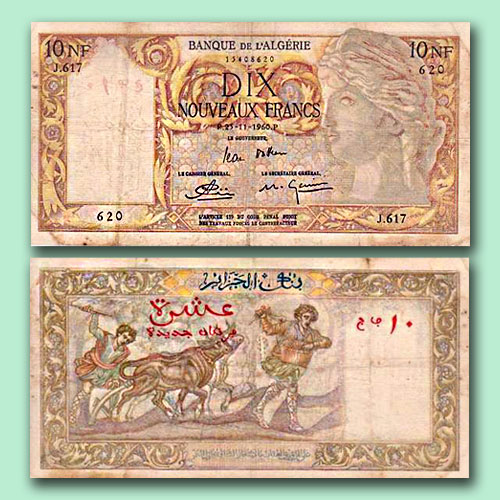Algerian 10 Nouveaux Francs 1960
2018-09-17 Mon
Algeria is a North African country with a Mediterranean coastline and a Saharan desert interior. The capital and most populous city is Algiers, located in the far north of the country. The country is a semi-presidential republic consisting of 48 provinces and 1,541 communes (counties).Many empires have left legacies here, such as the ancient Roman ruins in seaside Tipaza, the Ottoman landmarks like circa-1612 Ketchaoua Mosque line the hillside Casbah quarter, with its narrow alleys and stairways, in the capital, Algiers, the city’s Neo-Byzantine basilica Notre Dame d’Afrique dates to French colonial rule, etc.
With the 16th largest oil reserves in the world, the second largest in Africa and the 9th largest reserves of natural gas, Algeria supplies large amounts of natural gas to Europe, and energy exports are the backbone of the economy.
Algeria is classified as an upper middle income country by the World Bank. Though Algeria's current currency is the Dinar, the franc was the currency of Algeria between 1848 and 1964. It was subdivided into 100 centimes.
The Banque d'Algérie introduced its first notes in 1861. Denominations of 5, 10, 50, 100, 500 and 1000 francs were introduced by 1873 although the 10-franc note was issued only in 1871. Today we are discussing a 10 Nouveaux Francs banknote of Algeria issued in 1960. The note specifications are as follows:
The obverse has a portrait of Goddess Isis with the texts in French “Banque de l'Algerie; Dix Nouveaux Francs; L'Article 139 du Code Penal Punit des Travaux - Forces a Perpetuite le Contrefacteur”. The reverse portrays Algerian peasants sowing seeds and ploughing. The note portrays a very beautiful Watemark of the Ancient goddess Isis.
Image Courtesy: www.banknotes.com/
Latest News
-
Gold Pagoda of Vijaynagar Empire King Deva Raya I
2024-04-10 WedKing Deva Raya I of the Vijayanagara Empire was a patron of Kannada literature and architecture. He ...
-
Silver Denarius of Septimus Severus
2024-04-05 FriLucius Septimius Severus served as the Roman emperor from 193 to 211 AD. Severus sat on the throne o...
-
Extremely rare 'Malaharamari' type Gold Gadyana of King Guhalladeva-III Sold for INR 611000
2024-04-03 WedTribhuvanamalla, also known as Guhalladeva III, was the ruler of the Kadamba dynasty. His reign coin...
-
90 Years of RBI
2024-04-02 TueOn 1st April, PM #Modi unveiled a special commemorative coin marking 90 Years since the foundation o...
-
Silver Denarius of Julia Mamaea
2024-04-02 TueJulia Avita Mamaea, a Christian Syrian noblewoman, was the mother of Roman Emperor Alexander Severus...

